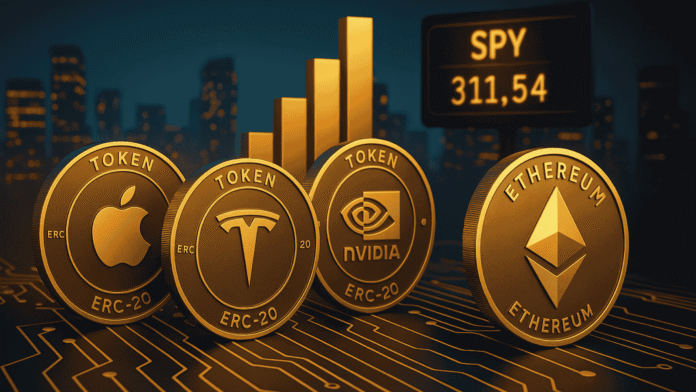Tokenization of real-world assets (RWAs) continues to gather momentum, and Backed Finance is leading the charge. The Swiss-based platform, known for offering tokenized versions of U.S. equities, has seen its product volume surge to $300 million, marking a pivotal moment in the blending of traditional finance with blockchain infrastructure.
This rapid growth underscores how investor demand for regulated, blockchain-native exposure to real-world stocks is heating up.
The Rise of Tokenized Securities
Backed Finance offers tokenized representations of popular U.S. stocks, such as Apple (bAAPL), Tesla (bTSLA), and Nvidia (bNVDA), alongside ETFs like the SPY. These assets are issued as ERC-20 tokens fully backed by their underlying equities, custodied in compliance with Swiss regulatory standards.
While the tokens can’t be redeemed by retail holders in the U.S. due to regulatory restrictions, they can be traded globally across DeFi protocols and secondary markets. For international users, they provide a way to gain access to U.S. markets without traditional broking accounts.
What makes these assets particularly attractive is their compatibility with the broader Ethereum and EVM ecosystem. Investors can provide liquidity, use them as collateral in lending protocols, or trade them peer-to-peer—all on-chain.
From Niche Product to $300 Million Milestone
When Backed launched its tokenized equity products, critics questioned the appetite. But in less than 12 months, the platform’s total value locked (TVL) and trade volume have ballooned.
Several factors contributed to this breakout:
- Rising interest in RWAs, particularly among institutional DeFi users
- Increased regulatory clarity in Europe, allowing compliant issuance
- Integration with lending and yield protocols like Aave and Morpho Blue
Tokenized equities have also benefited from macro trends. As equity markets rallied in Q2 2025 and inflation showed signs of cooling, more investors turned to blockchain-native instruments that mirrored their TradFi holdings.
Regulatory Greenlight in Europe Helps
A major advantage for Backed is its regulatory footing. Operating under Switzerland’s DLT Act and leveraging frameworks in the European Union, it can issue and manage these tokenized products with legal backing. That’s given institutions more comfort, especially family offices and fintechs seeking to experiment with blockchain rails.
In contrast, the U.S. market remains cautious. SEC guidance on tokenized equities is still murky, and most U.S.-based platforms offering similar products have either paused operations or restricted access.
This geographic divide has helped Backed capture global market share by focusing on Europe, Asia, and Latin America.
Infrastructure for the Future
Backed’s $300 million milestone isn’t just about volume—it signals growing confidence in infrastructure that bridges TradFi and DeFi. Projects like Backed, Franklin Templeton’s BENJI, and BlackRock’s BUIDL fund show that tokenized finance is no longer theoretical.
The next step may involve programmable dividends, corporate governance rights, and broader asset classes—like real estate or bonds. Already, Backed is exploring partnerships to bring tokenized fixed income to market by Q4 2025.
DeFi protocols are watching closely. The integration of real-world assets has the potential to reshape lending markets by introducing yield sources not dependent on crypto-native leverage. Tokenized stocks could also find use in structured products, synthetic indexes, and retail robo-advisors operating entirely on-chain.
Bottom Line
The $300 million in volume isn’t just a number. It’s a sign that real-world assets—long promised but slow to arrive—are finally gaining traction in the blockchain world. And Backed Finance is at the center of this shift.
For a space often criticised for lack of real utility, tokenized equities offer a glimpse of a future where financial products are accessible, transparent, and programmable. The rails are being built—and users are beginning to arrive.




